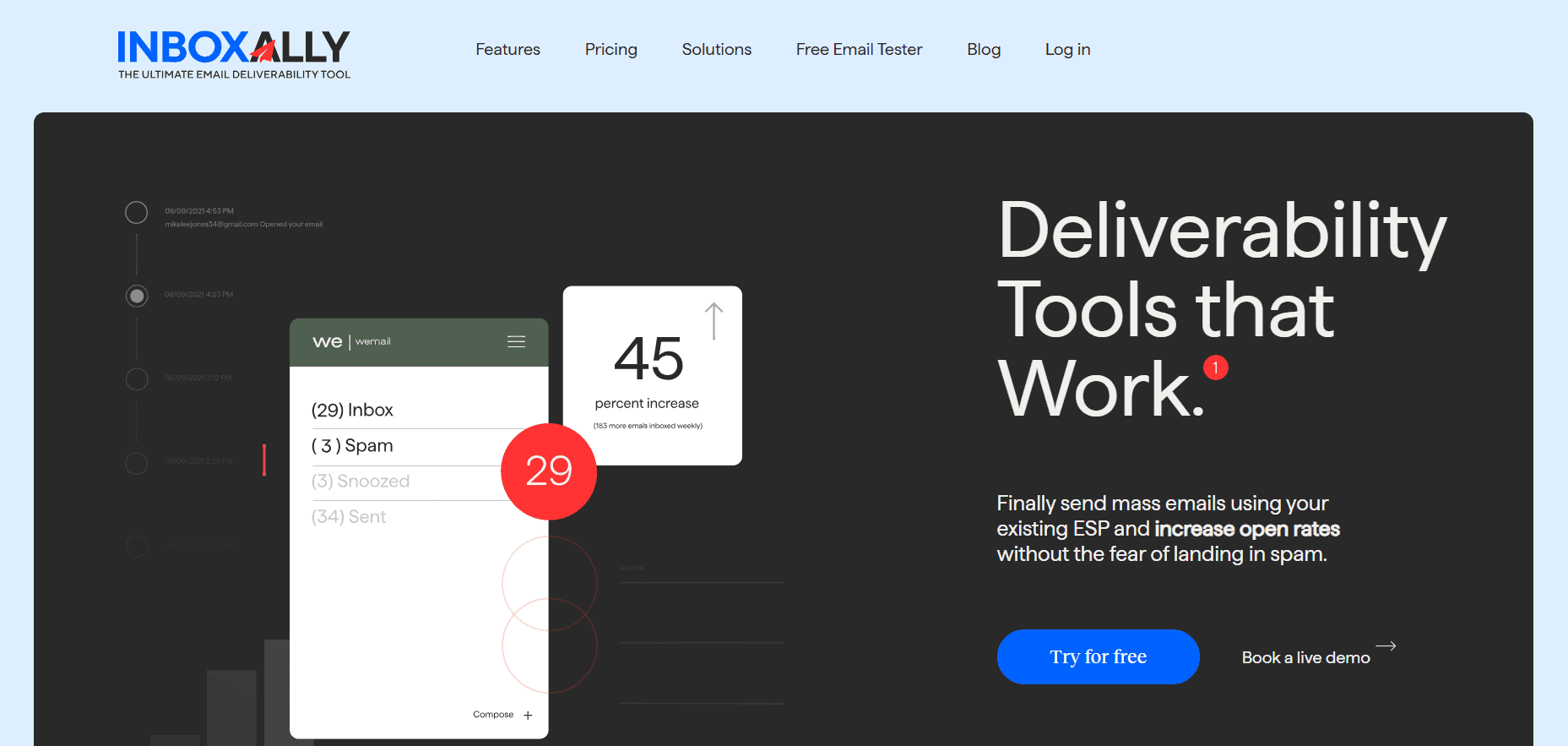- The Best Mailtrap Alternatives
- How I Chose These Alternatives
- 1. Inboxally: Best for improving inbox placement and deliverability.
- 2. SendGrid: Best for scalable transactional and marketing emails.
- 3. Mailgun: Best for developer-friendly transactional email API.
- 4. Brevo: Best for email marketing automation & CRM integration.
- 5. MailerLite: Best for budget-friendly email marketing for small businesses.
- 6. SendPulse: Best for multichannel marketing (email, SMS, chatbots).
- 7. UniOne: Best for cost-effective transactional email sending.
- 8. Litmus: Best for email testing and optimization.
- How to Choose the Best Mailtrap Alternative for You
Last Updated on May 30, 2025 by Ewen Finser
Listen, I get it, Mailtrap has a lot going for it. Between all the basic email marketing and analytics features and frankly reasonable price point, I get why it’s so popular.
But it’s not the only one out there. In fact, there are quite a few alternatives that match (and even exceed) Mailtrap’s offerings for a lower price.
I tested them out and came up with my list of top 8 Mailtrap alternatives that I think do a better job.
The Best Mailtrap Alternatives
- Inboxally (5/5)- Best for improving inbox placement and deliverability
- SendGrid (5/5)- Best for scalable transactional and marketing emails
- Mailgun (4.5/5)- Best for developer-friendly transactional email API
- Brevo (4.5/5)- Best for email marketing automation & CRM integration
- MailerLite (4/5)- Best for budget-friendly email marketing for small businesses
- SendPulse (4/5)- Best for multichannel marketing (email, SMS, chatbots)
- UniOne (3.5/5)- Best for cost-effective transactional email sending
- Litmus (4.5/5)- Best for email testing and optimization
How I Chose These Alternatives
I looked at some key things to pick these alternatives in particular, including:
- Features vs. Mailtrap – I looked for platforms that offered similar or even better features like email testing, inbox previews, transactional email support, and spam checking.
- Deliverability Tools – These tools in particular provide built-in deliverability monitoring and optimization, which is something Mailtrap focuses on with safe email testing.
- Marketing & Automation– I wanted to find some alternatives that went beyond testing (like Mailtrap) to include more marketing features such as email campaigns, workflows, and CRM integration.
- Ease of Integration – I assessed how easily each of these connects with existing apps and workflows through APIs or plugins, like Mailtrap’s developer-friendly vibe.
- Pricing & Scalability – I compared the pricing structures of each provider, especially compared to Mailtrap’s pricing tiers, and considered how scalable each platform is.
1. Inboxally: Best for improving inbox placement and deliverability.
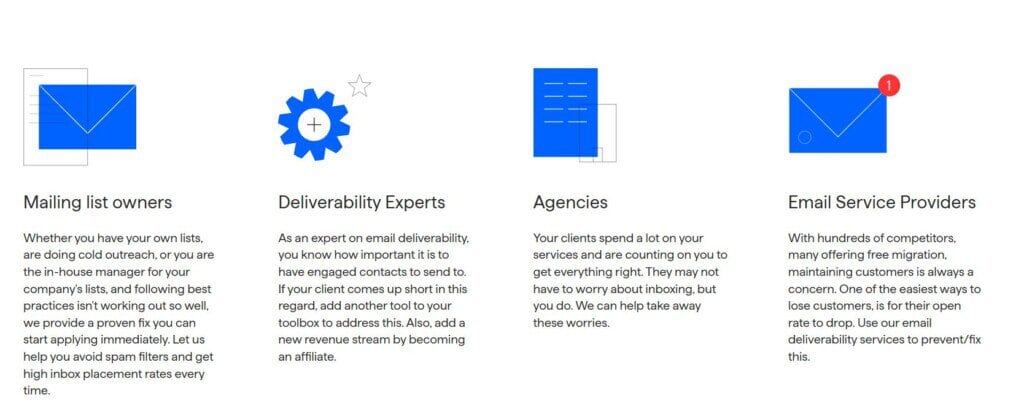
First up is my personal favorite, Inboxally. Inboxally is a service that is focused solely on improving your emails’ deliverability.
It does everything to make your emails more deliverable, including training ISPs to improve deliverability, improving your sender reputation the longer you use it, and detailed analytics on email placement, all in a user-friendly interface.
The only downside is that since it focuses on deliverability, it’s not an all-in-one solution, so you may have to integrate with other email tools for more services.
Pros
- Enhances email deliverability by training ISPs
- Improves your sender reputation over time
- Super user-friendly interface offering insights
- Detailed analytics about email placement
Cons
- Focuses solely on deliverability, so it’s not a full-service email platform
- Could require integration with other email services
- Pricier, maybe not great for small businesses
Features
- Inbox placement monitoring
- Deliverability training tools
- Detailed sender reputation reports
- Customizable spam filter testing
- Comprehensive analytics dashboard
InboxAlly is the comprehensive suite I need to solve challenging deliverability problems across the board. It's like a triage hub for diagnosing and fixing email deliverability rates in one dashboard. I've tried a lot of tools, but this is the one I've stuck with.
2. SendGrid: Best for scalable transactional and marketing emails.
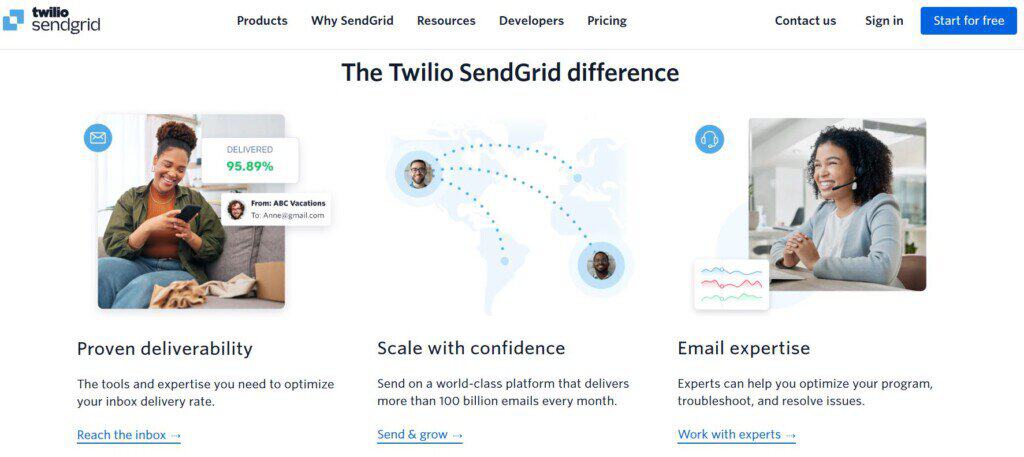
If you need to send a ton of emails, try SendGrid. This one includes the option to use the email API to integrate email to your app/site and an email marketing solution to design and run effective email marketing campaigns.
I dig how affordable, customizable, and scalable it is. You can start free and then upgrade your plan based on how many emails you need to send per month, making it super handy if your business is just starting out but has serious growth potential.
The downside here is that it’s just not the most user-friendly. The setup is tricky for newbies.
Try the first 100 emails for free, then get the Essentials plan from $19.95 per month.
Pros
- Powerful infrastructure designed for large volumes of emails
- Comprehensive analytics and reporting tools
- Great API integrations
- Reliable deliverability rates
Cons
- Difficult setup for beginners
- Customer support can be slow sometimes
- Advanced features require higher-tier plans
Features
- Email API for easy integration
- Customizable templating for personalized emails
- Advanced deliverability insights
- Comprehensive analytics suite
- SMTP relay for clean setup
3. Mailgun: Best for developer-friendly transactional email API.

Have a developer and the need for a better option for transactional emails? Check out Mailgun.
Their email API is created with developers in mind. It offers top-of-the-line APIs for sending, receiving, and tracking transactional emails. Plus, it’s highly scalable and super speedy, offering improved deliverability alongside its flexible integration into custom applications.
Free plan, then pricing from $15 per month.
Pros
- Developer-centric with powerful APIs
- Dedicated IP options
- Flexible pricing
- Real-time reporting
Cons
- Steeper learning curve for non-developers
- Limited in-app marketing tools
- Some features are only for the pricier plans
Features
- Strong email APIs
- Email validation service
- Inbound email routing
- Detailed analytics dashboard
- SMTP relay services
4. Brevo: Best for email marketing automation & CRM integration.
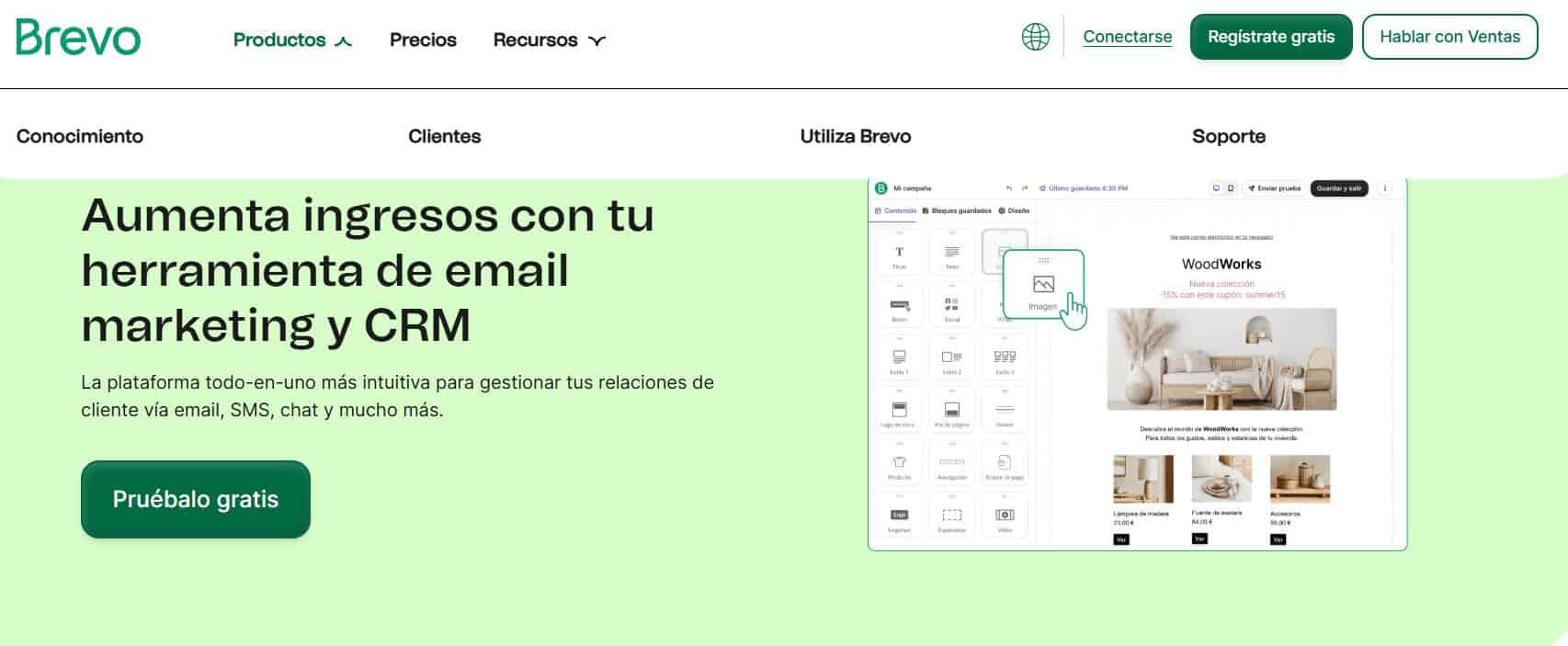
For a great all-in-one email marketing tool, check out Brevo.
Brevo, previously Sendinblue, combines email deliverability improvement with marketing and SMS all in one easy-to-use platform. I love that it also has a built-in CRM I can use to build customer relationships through communications.
Their free tier is especially generous, with 300 free emails per day, transactional emails included, and tons of free customizable email marketing templates with a drag-and-drop editor.
For larger businesses with more needs, the Starter plan starts at just $8.08 per month.
Pros
- All-in-one platform for both email and SMS marketing
- Built-in CRM for customer management
- Affordable pricing with a lot of stuff included in free tier
- User-friendly interface great for beginners
Cons
- Can be delays in email delivery
- Limited advanced automation capabilities
- Limited template customization
Features
- Email marketing campaigns
- SMS marketing integration
- Marketing automation workflows
- Built-in CRM system
- Transactional email capabilities
5. MailerLite: Best for budget-friendly email marketing for small businesses.
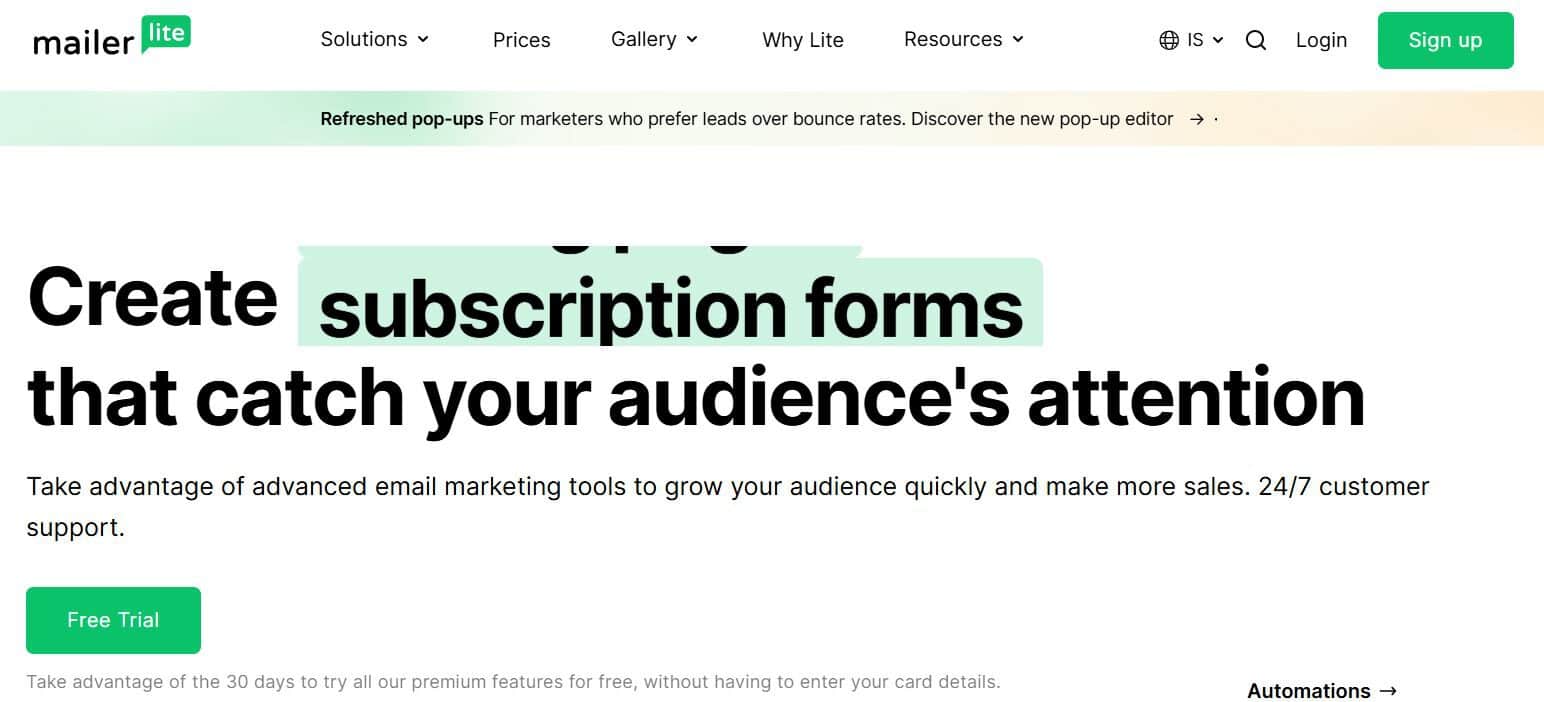
Small businesses need email marketing tools, too! For those, I recommend MailerLite.
It has everything a small business is looking for in an email marketing platform, including automation features, builders for landing pages and websites, and an easy-to-use interface, all at an incredibly affordable price.
Unfortunately, you’ll be missing out on just a few bells and whistles in trade for that cheap price. MailerLite has fewer segmentation options and more limited pre-made template variety than some competitors on this list.
The free option includes a generous 12,000 monthly emails, then pricing starts at $9 per month for unlimited emails.
Pros
- Intuitive and simple design
- Affordable pricing plans
- Offers landing page and website builders
- Great automation features for the price
Cons
- Less advanced segmentation options
- Fewer integrations compared to others on the list
- Limited template variety
Features
- Drag-and-drop email editor
- Automation workflows
- Landing page builder
- Subscriber management tools
- A/B testing capabilities
6. SendPulse: Best for multichannel marketing (email, SMS, chatbots).
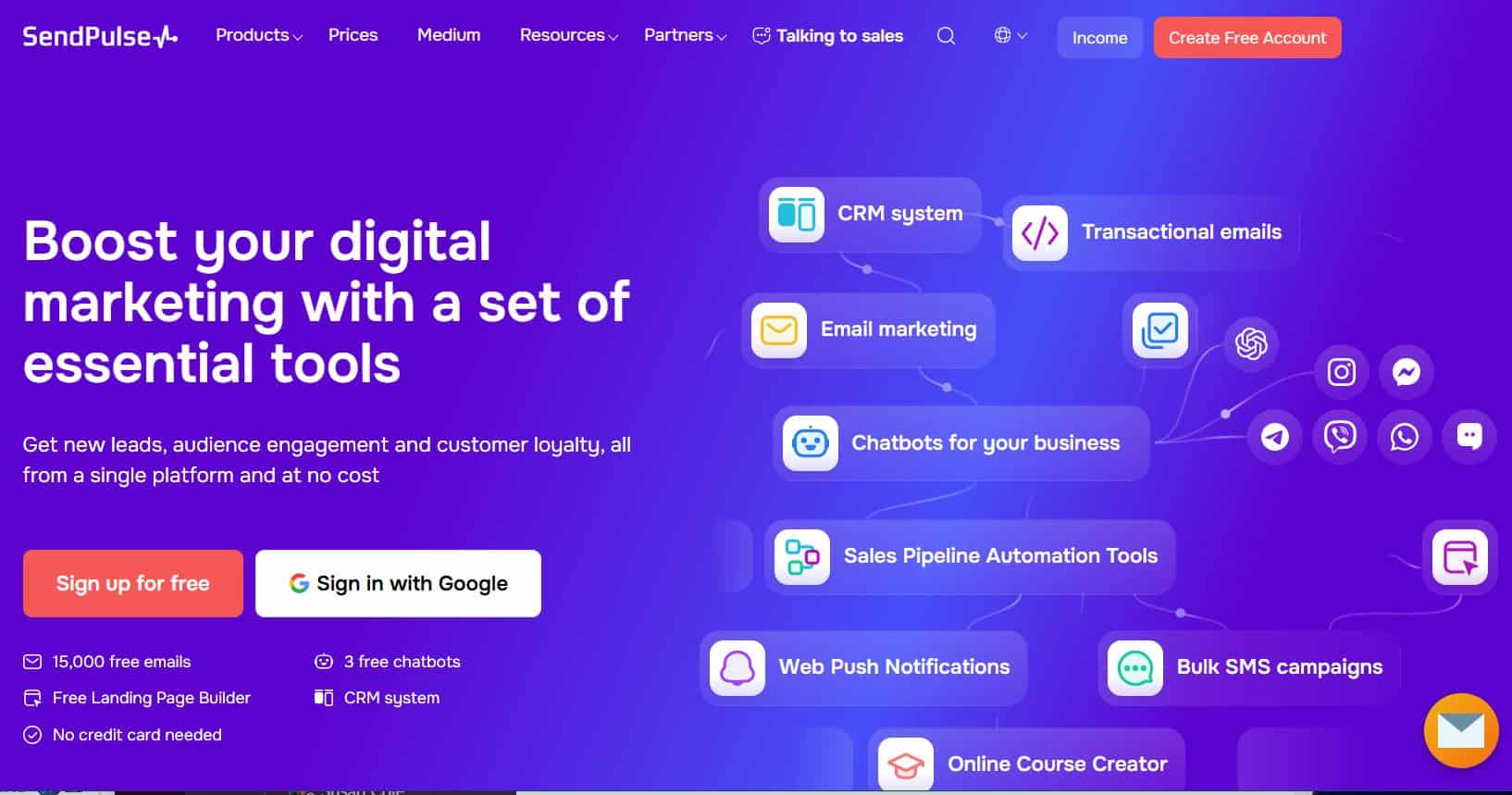
If you’re looking to centralize your SMS, email, chatbot, web push notifications, and more, I recommend you check out SendPulse.
SendPulse is a multi-channel marketing platform that allows you to manage everything from email marketing campaigns to virtual chatbots all in one place. I appreciate that SendPulse allows users to harness the power of AI to manage communications through multiple channels and offer predictive analytics based on performance, plus the integrated chatbot is great at fielding commonly asked questions.
Its biggest strength is also its weakness, as the interface can become cluttered due to the wide range of features this tool offers. But that’s really not a bad problem to have.
The free plan includes an incredible 15,000 emails, then pricing starts from $8 per month per user.
Pros
- Multi-channel marketing platform (email, SMS, web push)
- Predictive analytics AI
- Great free tier for startups
- Integrated chatbot
Cons
- Large number of features can make interface messy
- Email template designs are basic
- Automation features aren’t as advanced
Features
- Email marketing campaigns
- SMS messaging
- Web push notifications
- Chatbot builder
- AI-based subscriber rating
7. UniOne: Best for cost-effective transactional email sending.
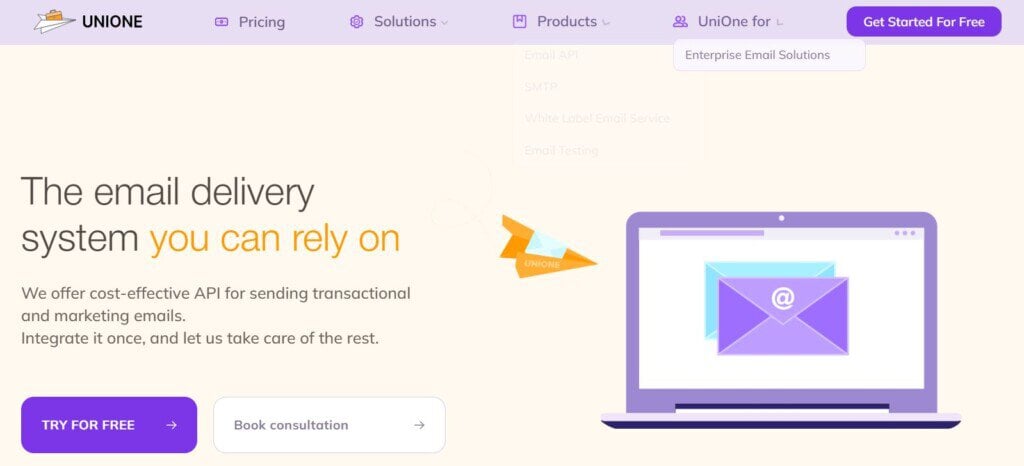
UniOne is the best option if you’re just looking for the most affordable way to send emails, as it costs a good few dollars less per month than others on this list, with a pretty good free plan available as well.
The standout here is the high deliverability rates of the emails that they send and they offer super-responsive 24/7 chat support. Another plus is the real-time analytics and reporting features that give users a live look into how your emails are performing.
The free plan includes 4 months with 6,000 emails per month, then plans start at $6 per month for 10,000 emails per month.
Pros
- High deliverability rates
- Clear pricing with no hidden fees
- Real-time analytics and reporting
- Responsive 24/7 customer support
Cons
- Less known in the market so there are fewer user reviews
- Fewer integrations than some others on this list
- Not as many advanced marketing features
Features
- 24/7 support in live chat and via email
- SPF, DKIM, and DMARC authentication for senders’ domains
- AI-powered HTML email editor
- Up to 45 days of log retention
- Dedicated IP $40/month + $20 one-time set-up fee per 1 dedicated IP address
8. Litmus: Best for email testing and optimization.
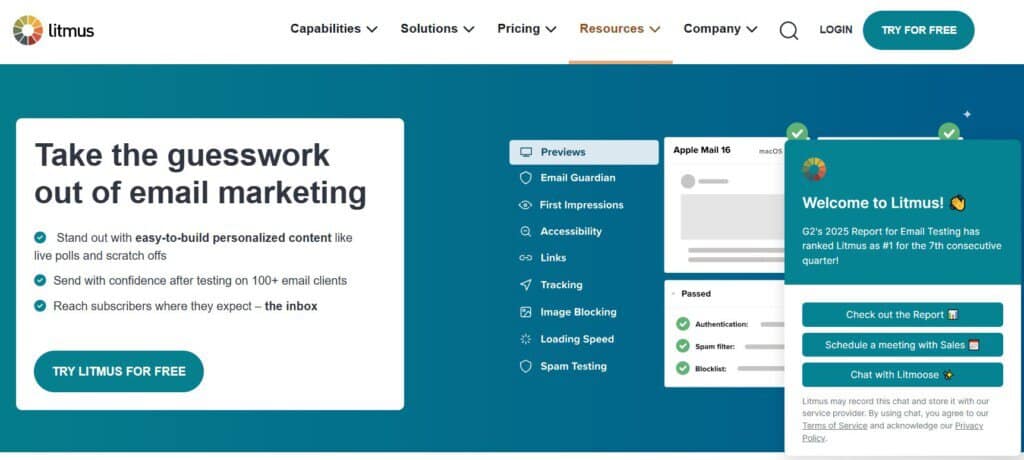
Pros
- Phenomenal email testing across different devices and clients
- Detailed analytics about email engagement and performance
- Collaboration tools for teams to work together
- Spam testing to identify deliverability issues early
Cons
- Not really an email sending platform (requires separate ESP)
- Expensive compared to other testing tools
- Can be overkill for small teams or simple campaigns
Features
- 24/7 email monitoring with Litmus Email Guardian
- Engagement analytics to track opens, clicks, reading time, and geolocation data
- Spam testing to check emails against spam filters
- Team collaboration features to collect feedback, approvals, and comments in one place during email
- Version control to track changes and manage different versions of your email design
How to Choose the Best Mailtrap Alternative for You
Here’s how you can choose the right Mailtrap alternative for your business’s needs:
- Define Your Needs– Are you focused on testing, transactional emails, deliverability, or full marketing campaigns?
- Compare Features – Look for tools that match (or exceed!) Mailtrap’s tools like sandbox testing, spam checks, and analytics.
- Check Deliverability Support – Focus on platforms that help improve inbox placement if deliverability is a challenge for you.
- Consider Budget and Scalability – Choose one that fits your current needs and can grow alongside your business.
- Look at Integration Options – Make sure the platform works with your existing workflows.
I’m partial to InboxAlly, but if you need something more robust, you might want to consider Brevo or SendPulse. Ultimately, what works best for you will depend on your individual needs.
InboxAlly is the comprehensive suite I need to solve challenging deliverability problems across the board. It's like a triage hub for diagnosing and fixing email deliverability rates in one dashboard. I've tried a lot of tools, but this is the one I've stuck with.


